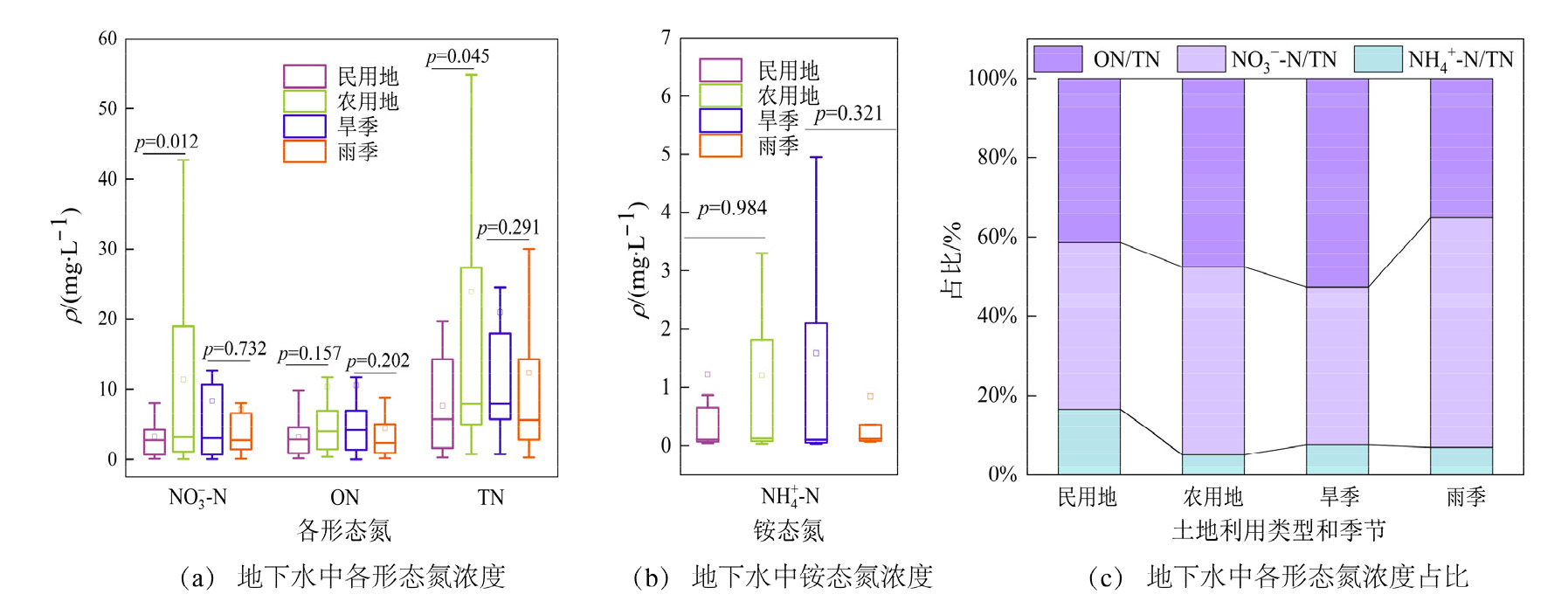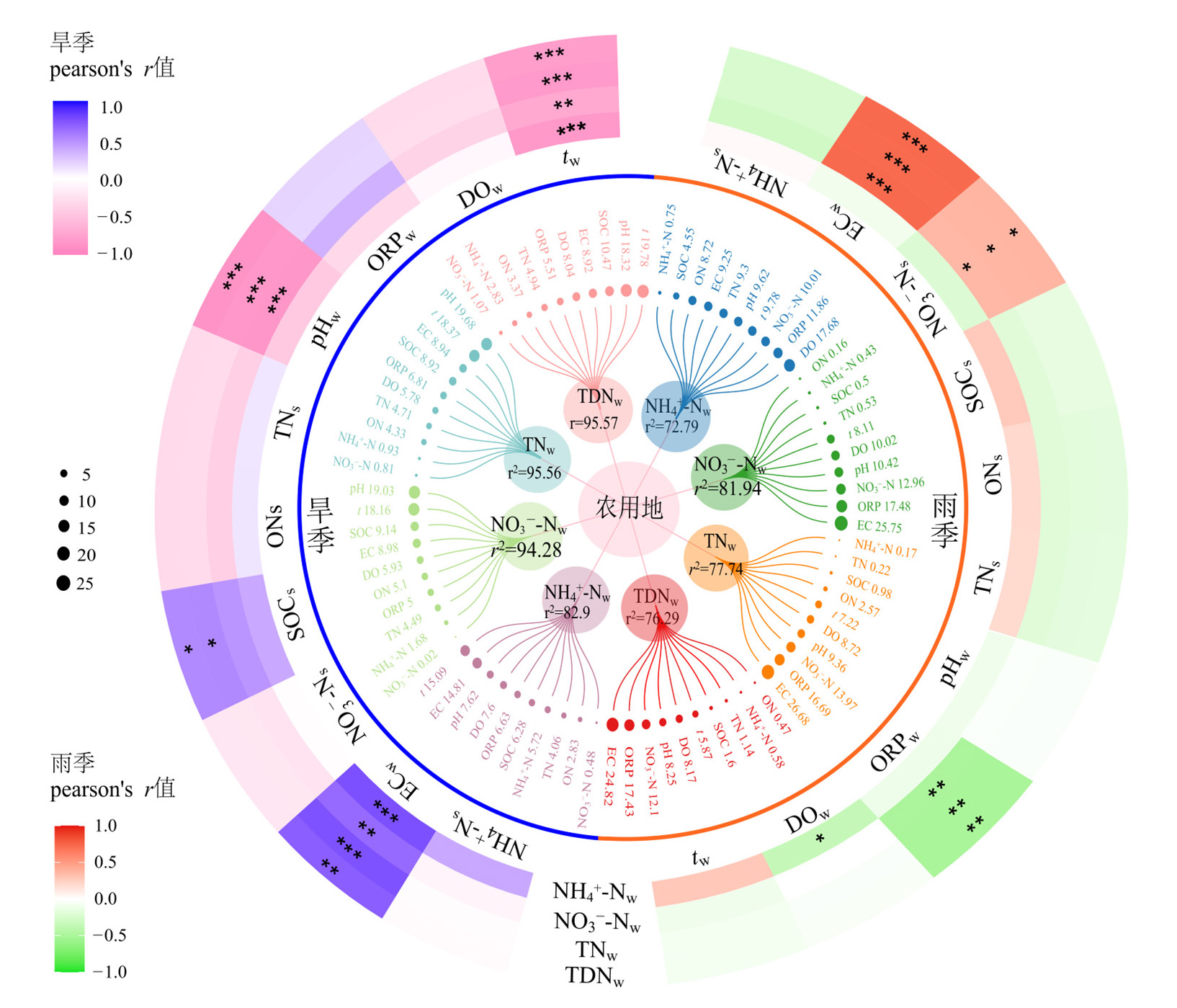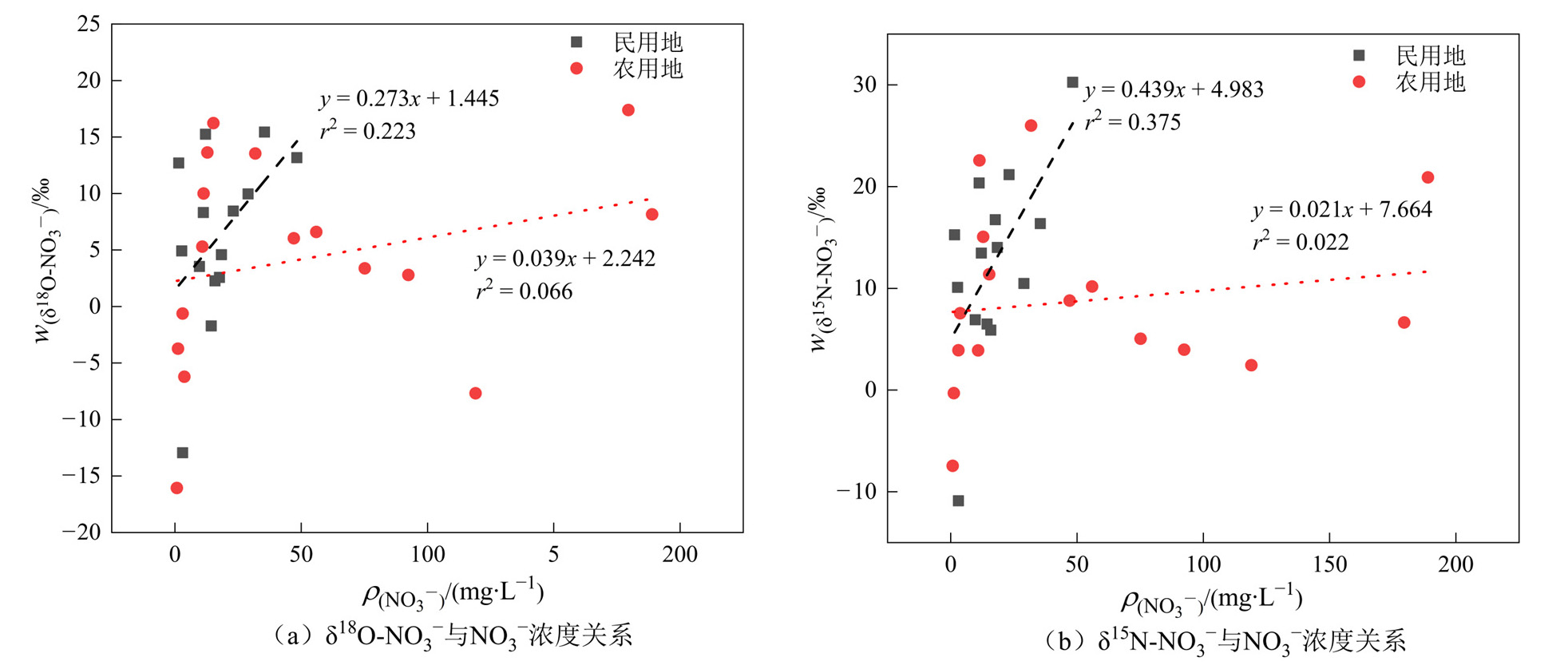生态环境学报 ›› 2025, Vol. 34 ›› Issue (4): 570-580.DOI: 10.16258/j.cnki.1674-5906.2025.04.007
蒋存征1( ), 陈安强2, 胡万里2, 付斌2, 朱林立3, 刘云娥4, 黎明琦1, 王炽2,*(
), 陈安强2, 胡万里2, 付斌2, 朱林立3, 刘云娥4, 黎明琦1, 王炽2,*( ), 张丹1,*(
), 张丹1,*( )
)
收稿日期:2024-09-27
出版日期:2025-04-18
发布日期:2025-04-24
通讯作者:
王炽。E-mail: saiyuwang@163.com作者简介:蒋存征(1998年生),男,硕士研究生,主要研究方向为农田土壤碳氮循环。E-mail: 320864273@qq.com
基金资助:
JIANG Cunzheng1( ), CHEN Anqiang2, HU Wanli2, FU Bin2, ZHU Linli3, LIU Yune4, LI Mingqi1, WANG Chi2,*(
), CHEN Anqiang2, HU Wanli2, FU Bin2, ZHU Linli3, LIU Yune4, LI Mingqi1, WANG Chi2,*( ), ZHANG Dan1,*(
), ZHANG Dan1,*( )
)
Received:2024-09-27
Online:2025-04-18
Published:2025-04-24
摘要: 明确异龙湖区浅层地下水中NO3−的主要来源、转化过程及主要驱动因素,对防治地下水氮污染和合理利用水资源具有重要意义。于2020年雨季(8月)和2021年旱季(5月)选择异龙湖区农田灌溉井(13个)和居民区生活用水井(10个),共采集46个地下水样品。运用水化学和氮氧同位素(δ15N-NO3−、δ18O-NO3−)技术并结合同位素混合模型(SIAR),明确地下水中NO3−的时空分布、转化过程、来源及不同来源氮对地下水NO3−的贡献。结果表明,地下水中氮浓度和形态均受土地利用和雨旱季变化的影响,农田地下水中氮浓度高于民用地,旱季高于雨季。农用地25%的采样点地下水ρ(NO3−-N)超过地下水III类水质要求(GB/T 14848—2017)规定的20 mg·L−1。水土环境对农用地浅层地下水氮浓度影响较大,反映和影响地下水氮浓度的关键性因子是水中的EC、pH、DO和温度(t),而土壤碳氮指标对地下水氮浓度影响较弱。硝化作用是异龙湖区地下水中主要的氮转化过程,地下水NO3−主要来源于粪污氮、土壤有机氮、化肥氮,其对民用地和农用地的贡献率分别为46.02%、25.83%、21.49%和35.27%、34.39%、24.57%。因此,改善污水收集处理设施、合理堆置和施用粪肥、控制土壤氮淋失是防治异龙湖区地下水中NO3−污染的重要策略。
中图分类号:
蒋存征, 陈安强, 胡万里, 付斌, 朱林立, 刘云娥, 黎明琦, 王炽, 张丹. 异龙湖区浅层地下水NO3−-N浓度时空变化及其来源解析[J]. 生态环境学报, 2025, 34(4): 570-580.
JIANG Cunzheng, CHEN Anqiang, HU Wanli, FU Bin, ZHU Linli, LIU Yune, LI Mingqi, WANG Chi, ZHANG Dan. Spatiotemporal Variations of NO3−-N Concentration in Shallow Groundwater around Yilong Lake and Its Source Analysis[J]. Ecology and Environment, 2025, 34(4): 570-580.

图4 地下水中各形态氮质量浓度及其占比 民用地地下水样本量N=20,农用地地下水样本量N=26,旱季地下水样本量N=23,雨季地下水样本量N=23,样本重复数n=3
Figure 4 Concentration and proportion of various forms of nitrogen in groundwater

图6 不同季节地下水中各形态氮浓度与环境因子的关系
Figure 6 Relationship between nitrogen concentrations of various forms and environmental factors in groundwater in different seasons

图8 地下水δ15N-NO3?和δ18O-NO3?与NO3?浓度关系 民用地地下水氮氧同位素样本量N=14,农用地样本量N=16,样本重复数n=3
Figure 8 Relationship between δ15N-NO3? or δ18O-NO3? and NO3? concentration in groundwater
| [1] | BIDDAU R, DORE E, DA PELO S, et al., 2023. Geochemistry, stable isotopes and statistic tools to estimate threshold and source of nitrate in groundwater (Sardinia, Italy)[J]. Water Research, 232: 119663. |
| [2] | CHEN Z X, YU L, LIU W G, et al., 2014. Nitrogen and oxygen isotopic compositions of water-soluble nitrate in Taihu Lake water system, China: Implication for nitrate sources and biogeochemical process[J]. Environmental Earth Sciences, 71: 217-223. |
| [3] | CHEN A Q, LEI B K, HU W L, et al., 2018. Temporal-spatial variations and influencing factors of nitrogen in the shallow groundwater of the nearshore vegetable field of Erhai Lake, China[J]. Environmental Science and Pollution Research, 25(5): 4858-4870. |
| [4] | CUI R Y, FU B, MAO K M, et al., 2020. Identification of the sources and fate of NO3--N in shallow groundwater around a plateau lake in southwest China using NO3- isotopes (δ15N and δ18O) and a Bayesian model[J]. Journal of Environmental Management, 270: 110897. |
| [5] | CHEN A Q, ZHANG D, WANG H Y, et al., 2022. Shallow groundwater fluctuation: An ignored soil N loss pathway from cropland[J]. Science of The Total Environment, 828: 154554. |
| [6] | DING J T, XI B D, GAO R T, et al., 2014. Identifying diffused nitrate sources in a stream in an agricultural field using a dual isotopic approach[J]. Science of the Total Environment, 484: 10-18. |
| [7] | GU B J, GE Y, CHANG S X, et al., 2013. Nitrate in groundwater of China: Sources and driving forces[J]. Global Environmental Change, 23(5): 1112-1121. |
| [8] | HAN D M, CURRELL M J, CAO G L, 2016. Deep challenges for China’s war on water pollution[J]. Environmental Pollution, 218: 1222-1233. |
| [9] | HE B N, HE J T, WANG L, et al., 2019. Effect of hydrogeological conditions and surface loads on shallow groundwater nitrate pollution in the Shaying River Basin: Based on least squares surface fitting model[J]. Water Research, 163: 114880. |
| [10] | HU M M, WANG Y C, DU P C, et al., 2019. Tracing the sources of nitrate in the rivers and lakes of the southern areas of the Tibetan Plateau using dual nitrate isotopes[J]. Science of the Total Environment, 658: 132-140. |
| [11] | JIAO X Y, MAIMAITIYIMING A, SALAHOU M K, et al., 2017. Impact of groundwater level on nitrate nitrogen accumulation in the vadose zone beneath a cotton field[J]. Water, 9(3): 171. |
| [12] | JUNG H J, KIM Y S, YOO J S, et al., 2023. Identification of nitrate sources in tap water sources across South Korea using multiple stable isotopes: Implications for land use and water management[J]. Science of The Total Environment, 864: 161026. |
| [13] | KAUSHAL S S, GROFFMAN P M, BAND L E, et al., 2011. Tracking nonpoint source nitrogen pollution in human-impacted watersheds[J]. Environmental Science & Technology, 45(19): 8225-8232. |
| [14] | MEGHDADI A, JAVAR N, 2018. Quantification of spatial and seasonal variations in the proportional contribution of nitrate sourcesusing a multi-isotope approach and Bayesian isotope mixing model[J]. Environmental Pollution, 235: 207-222. |
| [15] | MALLYA C L, RWIZA M J, 2021. Influence of land use change on nitrate sources and pollutant enrichment in surface and groundwater of a growing urban area in Tanzania[J]. Environmental Earth Sciences, 80(3): 111. |
| [16] | LI J, ZHU D N, ZHANG S, et al., 2022. Application of the hydrochemistry, stable isotopes and MixSIAR model to identify nitrate sources and transformations in surface water and groundwater of an intensive agricultural karst wetland in Guilin, China[J]. Ecotoxicology and Environmental Safety, 231: 113205. |
| [17] | ROGERS K M, VAN DER RAAIJ R, PHILLIPS A, et al., 2023. A national isotope survey to define the sources of nitrate contamination in New Zealand freshwaters[J]. Journal of Hydrology, 617(Part C): 129131. |
| [18] |
WICK K, HEUMESSER C, SCHMID E, 2012. Groundwater nitrate contamination: Factors and indicators[J]. Journal of Environmental Management, 111: 178-186.
DOI PMID |
| [19] | WANG S Q, ZHENG W B, CURRELL M, et al., 2017. Relationship between land-use and sources and fate of nitrate in groundwater in a typical recharge area of the North China Plain[J]. Science of the Total Environment, 609: 607-620. |
| [20] | WANG Y J, PENG J F, CAO X F, et al., 2020. Isotopic and chemical evidence for nitrate sources and transformation processes in a plateau lake basin in Southwest China[J]. Science of the Total Environment, 711: 134856. |
| [21] | WU P Y, XIAO Q, GUO Y L, et al., 2022. Migration, transformation and nitrate source in the Lihu Underground River based on dual stable isotopes of δ15N-NO3- and δ18O-NO3-[J]. Environmental Science and Pollution Research, 29(32): 48661-48674. |
| [22] | ZHANG D, FAN M P, LIU H B, et al., 2020. Effects of shallow groundwater table fluctuations on nitrogen in the groundwater and soil profile in the nearshore vegetable fields of Erhai Lake, southwest China[J]. Journal of Soils and Sediments, 20: 42-51. |
| [23] | 白莹, 薛山, 鲁善海, 等, 2016. 沙颍河流域平原区土壤氮空间分布特征及影响因素研究[J]. 南京大学学报(自然科学), 52(1): 65-76. |
| BAI Y, XUE S, LU S H, et al., 2016. The influence of soil physics and chemical properties on groundwater nitrogen pollution in the riparian zone of Shaying River[J]. Journal of Nanjing University (Natural Sciences), 52(1): 65-76. | |
| [24] | 陈清飞, 陈安强, 崔荣阳, 等, 2023. 滇池周边浅层地下水硝酸盐来源及转化过程识别[J]. 环境科学, 44(11): 6062-6070. |
| CHEN Q F, CHEN A Q, CUI R Y, et al., 2023. Identification of nitrate source and transformation process in shallow groundwater around Dianchi Lake[J]. Environmental Science, 44(11): 6062-6070. | |
| [25] | 丛鑫, 张珊珊, 徐征和, 等, 2021. 华北典型超采区浅层地下水 “三氮” 时空变异及驱动因素分析[J]. 地球与环境, 49(6): 603-614. |
| CONG X, ZHANG S S, XU Z H, et al., 2021. Spatio temporal variation and driving factors of “three nitrogen” in shallow groundwater in typical overexploited areas in North China[J]. Earth and Environment, 49(6): 603-614. | |
| [26] | 党秀宁, 刘亚磊, 张子燕, 等, 2024. 十堰城区地表水-地下水水化学特征及硝酸盐来源[J/OL]. 环境科学, 1-15 [2024-11-22]. https://doi.org/10.13227/j.hjkx.202401209. |
| DANG X N, LIU Y L, ZHANG Z Y, et al., 2024. Hydrochemical characteristics of surface water and groundwater in shiyan urba area and sources of nitrate[J/OL]. Environmental Science, 1-15 [2024-11-22]. https://doi.org/10.13227/j.hjkx.202401209. | |
| [27] | 杜新强, 方敏, 冶雪艳, 2018. 地下水 “三氮” 污染来源及其识别方法研究进展[J]. 环境科学, 39(11): 5266-5275. |
| DU X Q, FANG M, YE X Y, 2018. Research progress on the sources of inorganic nitrogen pollution in groundwater and identification methods[J]. Environmental Science, 39(11): 5266-5275. | |
| [28] | 董一慧, 刘春篁, 昝金晶, 等, 2021. 鄱阳湖流域浅层地下水硝酸盐氮时空分布特征与来源[J]. 长江流域资源与环境, 30(12): 2972-2981. |
| DONG Y H, LIU C H, JIU J J, et al., 2021. Temporal and spatial distribution characteristics and sources of nitrate nitrogen in shallow groundwater of Poyang Lake Basin[J]. Resources and Environment in the Yangtze Basin, 30(12): 2972-2981. | |
| [29] | 范祖金, 魏兴, 周育琳, 等, 2023. 典型山地农业区浅层地下水硝酸盐来源及转化过程解析[J]. 环境科学研究, 36(10): 1946-1956. |
| FAN Z J, WEI X, ZHOU Y L, et al., 2023. Analysis of nitrate sources and transformation processes in shallow groundwater in typical mountainous agricultural area[J]. Research of Environmental Sciences, 36(10): 1946-1956. | |
| [30] | 全国国土资源标准化技术委员会 (SAC/TC 93), 2017. 地下水质量标准: GB/T 14848—2017[S]. |
| Natural Resources and Territory Spatial Planning (SAC/TC 93), 2017. Standard for groundwater quality: GB/T 14848—2017[S]. | |
| [31] | 傅雪梅, 孙源媛, 苏婧, 等, 2019. 基于水化学和氮氧双同位素的地下水硝酸盐源解析[J]. 中国环境科学, 39(9): 3951-3958. |
| FU X M, SUN Y Y, SU J, et al., 2019. Source of nitrate in groundwater based on hydrochemical and dual stable isotopes[J]. China Environmental Science, 39(9): 3951-3958. | |
| [32] | 江南, 周明华, 李红, 等, 2020. 长江上游典型山地农业小流域浅层地下水硝态氮时空变异特征及影响因素[J]. 环境科学, 41(10): 4539-4546. |
| JIANG N, ZHOU M H, LI H, et al., 2020. Spatial-temporal variations and the regulators of nitrate status in shallow groundwater of the typical mountainous agricultural watershed in the upper reaches of the Yangtze River[J]. Environmental Science, 41(10): 4539-4546. | |
| [33] | 李瑞, 肖琼, 刘文, 等, 2015. 运用硫同位素、氮氧同位素示踪里湖地下河硫酸盐、硝酸盐来源[J]. 环境科学, 36(8): 2877-2886. |
| LI R, XIAO Q, LIU W, et al., 2015. Using δ34S-SO42- and δ15N-NO3-, δ18O-NO3- to trace the sources of sulfur and nitrate in Lihu Lake under groundwater, Guangxi, China[J]. Environmental Science, 36(8): 2877-2886. | |
| [34] |
路路, 戴尔阜, 程千钉, 等, 2019. 基于水环境化学及稳定同位素联合示踪的土地利用类型对地下水体氮素归趋影响[J]. 地理学报, 74(9): 1878-1889.
DOI |
|
LU L, DAI E F, CHENG Q D, et al., 2019. Effects of land use types on nitrogen fate in groundwater based on water environmental chemistry and stable isotope tracing[J]. Acta Geographica Sinica, 74(9): 1878-1889.
DOI |
|
| [35] | 李晓欣, 王仕琴, 陈肖如, 等, 2021. 北方区域尺度地下水-包气带硝酸盐分布与变化特征[J]. 中国生态农业学报(中英文), 29(1): 208-216. |
| LI X X, WANG S H, CHEN X R, et al., 2021. Spatial distribution and changes of nitrate in the vadose zone and underground water in northern China[J]. Chinese Journal of Eco-Agriculture, 29(1): 208-216. | |
| [36] | 李桂芳, 杨恒, 叶远行, 等, 2022. 高原湖泊周边浅层地下水: 氮素时空分布及驱动因素[J]. 环境科学, 43(6): 3027-3036. |
| LI G F, YANG H, YE Y H, et al., 2022. Shallow groundwater around plateau lakes: spatiotemporal distribution of nitrogen and its driving factors[J]. Environmental Science, 43(6): 3027-3036. | |
| [37] | 李宝玲, 杨丽虎, 宋献方, 等, 2024. 沙颍河典型河段河岸带土壤理化性质对地下水氮污染的影响[J]. 中国环境科学, 44(7): 3955-3965. |
| LI B L, YANG L H, SONG X F, et al., 2024. The influence of soil physics and chemical properties on groundwater nitrogen pollution in the riparian zone of Shaying River[J]. China Environmental Science, 44(7): 3955-3965. | |
| [38] | 闵金恒, 陈安强, 李林, 等, 2024. 不同气候类型高原湖区浅层地下水中氮素来源及其贡献的差异[J]. 环境科学, 45(10): 5790-5799. |
| MIN J H, CHEN A Q, LI L, et al., 2024. Differences in nitrogen sources and contributions in shallow groundwater in plateau lake area with different climate types[J]. Environmental Science, 45(10): 5790-5799. | |
| [39] | 任坤, 潘晓东, 梁嘉鹏, 等, 2021. 碳氮氧同位素解析典型岩溶流域地下水中硝酸盐来源与归趋[J]. 环境科学, 42(5): 2268-2275. |
| REN K, PAN X D, LIANG J P, et al., 2021. Source and fate of nitrate in groundwater of typical karst basin by carbon nitrogen oxygen isotope analysis[J]. Environmental Science, 42(5): 2268-2275. | |
| [40] | 涂春霖, 陈庆松, 尹林虎, 等, 2024. 我国地下水硝酸盐污染及源解析研究进展[J]. 环境科学, 45(6): 3129-3141. |
| TU C L, CHEN Q S, YIN L H, et al., 2024. Research advances of groundwater nitrate pollution and source apportionment in China[J]. Environmental Science, 45(6): 3129-3141. | |
| [41] | 王贺, 谷洪彪, 迟宝明, 等, 2016. 柳江盆地浅层地下水硝酸盐分布特征及影响因素分析[J]. 环境科学, 37(5): 1699-1706. |
| WANG H, GU H B, CHI B M, et al., 2016. Distribution characteristics and influencing factors of nitrate pollution in shallow groundwater of Liujiang Basin[J]. Environmental Science, 37(5): 1699-1706. | |
| [42] | 吴志强, 潘林艳, 代俊峰, 等, 2022. 漓江流域岩溶与非岩溶农业小流域水体硝酸盐源解析[J]. 农业工程学报, 38(6): 61-71. |
| WU Z Q, PAN L Y, DAI J F, et al., 2022. Nitrate source apportionment of water in karst and non-karst agricultural sub-basins in the Lijiang River Basin of Guilin, Guangxi, China[J]. Transactions of the Chinese Society of Agricultural Engineering, 38(6): 61-71. | |
| [43] |
王刚, 高宏斌, 龙焙, 等, 2024. 硝酸盐同位素耦合多示踪剂溯源地下水硝酸盐污染研究进展[J]. 应用生态学报, 35(4): 970-984.
DOI |
|
WANG G, GAO H B, LONG P, et al., 2024. Research progress of nitrate isotope coupling multi tracer tracing groundwater nitrate pollution[J]. Chinese Journal of Applied Ecology, 35(4): 970-984.
DOI |
|
| [44] | 徐志伟, 张心昱, 于贵瑞, 等, 2014. 中国水体硝酸盐氮氧双稳定同位素溯源研究进展[J]. 环境科学, 35(8): 3230-3238. |
| XU Z W, ZHANG X Y, YU G R, et al., 2014. Review of dual stable isotope technique for nitrate source identification in surface and groundwater in China[J]. Environmental Science, 35(8): 3230-3238. | |
| [45] | 雍亮, 王毅博, 冯民权, 2023. 混合土地利用下长河流域硝酸盐污染源解析[J]. 环境科学学报, 43(7): 56-69. |
| YONG L, WANG Y B, FENG M Q, 2023. Analysis of nitrate pollution sources in Changhe River Basin under mixed land use[J]. Acta Scientiae Circumstantiae, 43(7): 56-69. | |
| [46] | 叶远行, 陈安强, 李林, 等, 2024. 休耕对抚仙湖周边农田土壤剖面和浅层地下水中氮累积的影响[J]. 环境科学, 45(6): 3226-3233. |
| YE Y X, CHEN A Q, LI L, et al., 2024. Effect of fallow on nitrogen accumulation in soil profile and shallow groundwater in cropland around Fuxian Lake[J]. Environmental Science, 45(6): 3226-3233. | |
| [47] | 周溪滢, 冯威, 杨立群, 等, 2021. 西干渠水体污染时空分布特征和影响因素分析[J]. 环境科学与技术, 44(S1): 82-87. |
| ZHOU X Y, FENG W, YANG L Q, et al., 2021. Spatial and temporal distribution characteristics and influencing factors of water pollution in the Xigan canal[J]. Environmental Science & Technology, 44(S1): 82-87. | |
| [48] | 张文芮, 张妍, 石雯敏, 等, 2022. 渭河流域关中段地下水硝态氮来源解析[J]. 中国环境科学, 42(10): 4758-4767. |
| ZHANG W R, ZHANG Y, SHI W M, et al., 2022. The source identification of nitrate in groundwater in Guanzhong section of Weihe River basin[J]. China Environmental Science, 42(10): 4758-4767. | |
| [49] | 张列宇, 马阳阳, 李国文, 等, 2023. 稳定同位素技术在水体硝酸盐污染源解析中的研究进展[J]. 环境工程技术学报, 13(4): 1373-1383. |
| ZHANG L Y, MA Y Y, LI G W, et al., 2023. Research progress of stable isotopes in source analysis of nitrate pollution in water[J]. Journal of Environmental Engineering Technology, 13(4): 1373-1383. | |
| [50] | 赵婉宁, 崔纪京, 白利勇, 等, 2023. 流域水环境硝酸盐源解析方法研究进展[J]. 环境工程, 41(8): 286-294. |
| ZHAO W N, CUI J J, BAI L Y, et al., 2023. Research progress of nitrate source apportionment methods in watershed water environment[J]. Environmental Engineering, 41(8): 286-294. |
| [1] | 郭铭彬, 龚建周, 王丽娟, 王时宽. 2019-2023年粤港澳大湾区NO2浓度变化的自然主控因子解析[J]. 生态环境学报, 2025, 34(4): 534-547. |
| [2] | 陈鹏, 马育军, 张梦雅, 陈婉婷, 江晓鹏. 基于kNDVI的广东省植被动态变化分析[J]. 生态环境学报, 2025, 34(4): 499-510. |
| [3] | 郭昭, 师芸, 刘铁铭, 张雨欣, 闫永智. 2001-2020年秦岭北麓NPP时空格局及驱动因素分析[J]. 生态环境学报, 2025, 34(3): 401-410. |
| [4] | 赵乐鋆, 王诗瑶, 赵子渝, 洪星, 李夫星, 吴佳仪, 华婧妤. 2008-2022年华北平原七省市AOD时空变化特征及主要影响因素分析[J]. 生态环境学报, 2025, 34(2): 256-267. |
| [5] | 侯金龙, 马志强, 杨澄, 葛双双, 何迪, 董璠. 京津冀地区植被碳源/汇的时空变化特征及影响因素分析[J]. 生态环境学报, 2024, 33(9): 1329-1338. |
| [6] | 王捷纯, 邓玉娇, 朱怀卫, 孔蕴淇. 广东省不同生态系统植被NPP时空变化及对气候因子的响应[J]. 生态环境学报, 2024, 33(6): 831-840. |
| [7] | 陈晓辉, 胡喜生. 耦合ER和GWR的福州市生态环境质量的驱动力分析[J]. 生态环境学报, 2024, 33(5): 812-823. |
| [8] | 张淼, 王桂霞, 王昌伟, 贺艳云, 许艳芳, 李琪, 许杨, 张俊骁, 张桂芹. 济南市区黑碳污染变化特征及来源解析[J]. 生态环境学报, 2024, 33(4): 560-572. |
| [9] | 杨非凡, 何浩. 基于“EVI-ESV”伊犁河谷生态环境评估及生态分区构建[J]. 生态环境学报, 2024, 33(4): 655-664. |
| [10] | 卢安康, 赵冠华, 王辉, 周立坚, 唐胜群, 彭志龙. 放射性同位素14C测年在岩溶地下水中的应用及研究进展[J]. 生态环境学报, 2024, 33(3): 487-498. |
| [11] | 李霞, 陈永昊, 陈喆, 张国壮, 唐梦雅. 中国沿海地区植被NDVI时空变化及驱动力分析[J]. 生态环境学报, 2024, 33(2): 180-191. |
| [12] | 罗小玲, 刘军, 王琦, 刘同旭, 梁耀杰, 谢志宜, 王中伟, 陈多宏. 2016年以来广东省不同土地利用类型土壤pH和有机质时空变化及其影响因素分析[J]. 生态环境学报, 2024, 33(12): 1849-1861. |
| [13] | 官国庆, 黄紫琳, 江龙飞, 罗春玲. 伴矿景天对重金属-多环芳烃复合污染土壤有机污染物消减及微生物的影响[J]. 生态环境学报, 2024, 33(12): 1931-1943. |
| [14] | 陈燕, 杨慧, 宁静, 朱德根, 吴夏, 黄芬, 马洋, 陈伟, Mitja Prelovšek, Nataša Ravbar. 重度干旱条件下典型岩溶区植被恢复过程中植物水分利用来源和效率研究[J]. 生态环境学报, 2024, 33(10): 1534-1543. |
| [15] | 温丽容, 林勃机, 李婷婷, 张子洋, 张正恩, 江明, 周炎, 张涛, 李军, 张干. 基于多同位素的珠三角PM2.5中二次无机气溶胶来源解析[J]. 生态环境学报, 2023, 32(9): 1654-1662. |
| 阅读次数 | ||||||
|
全文 |
|
|||||
|
摘要 |
|
|||||
